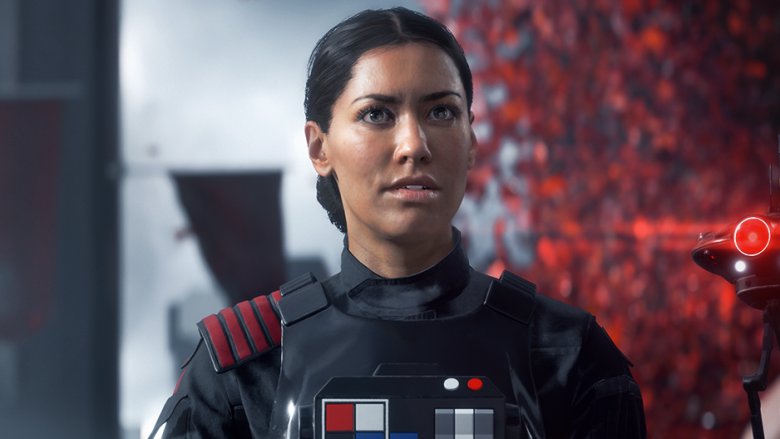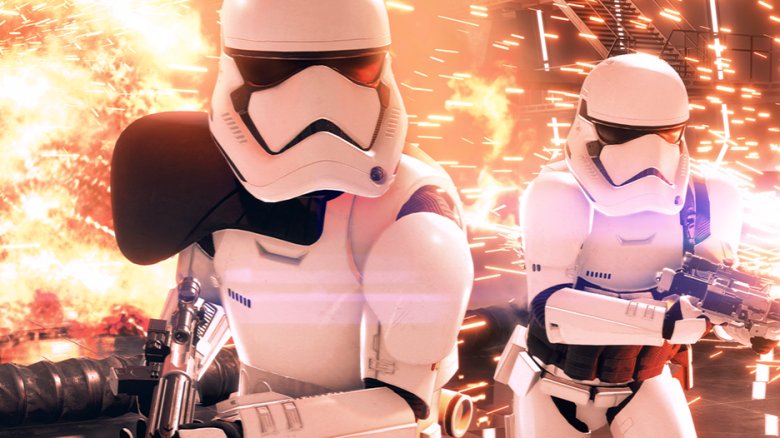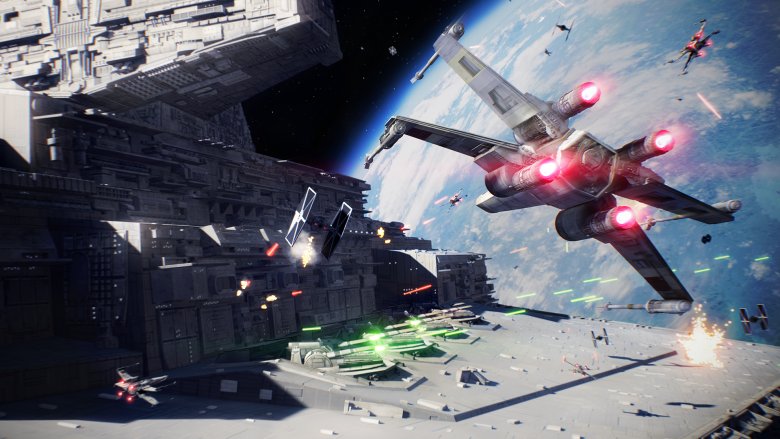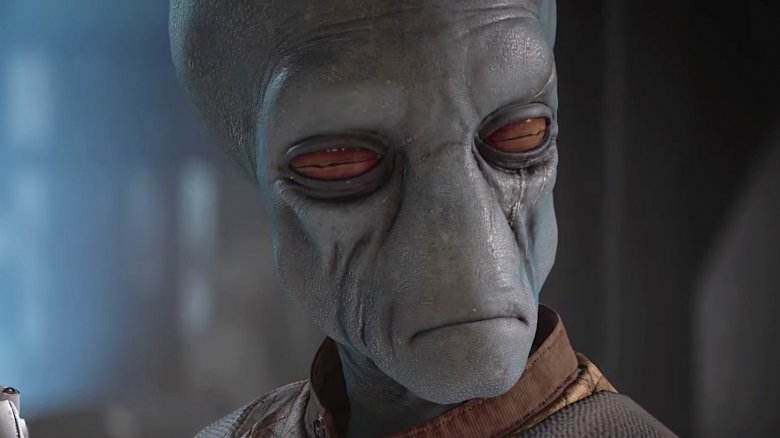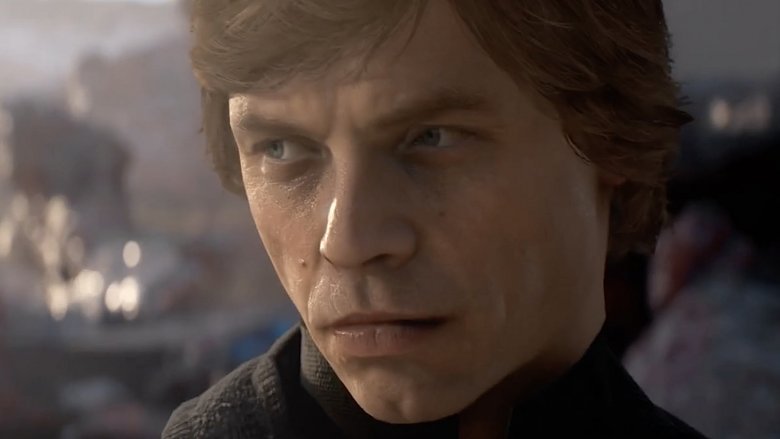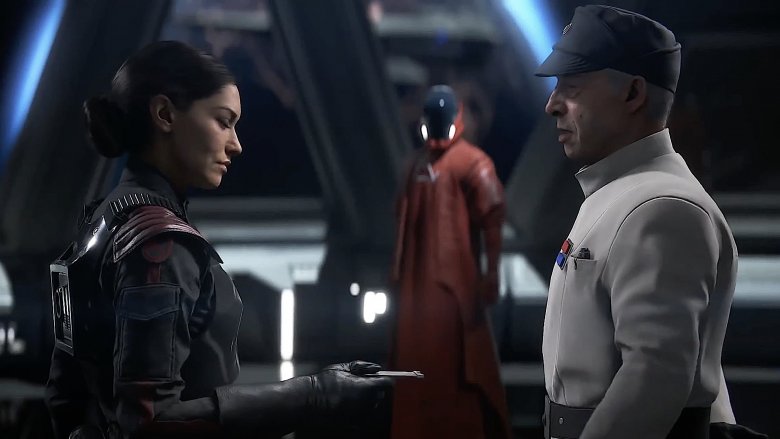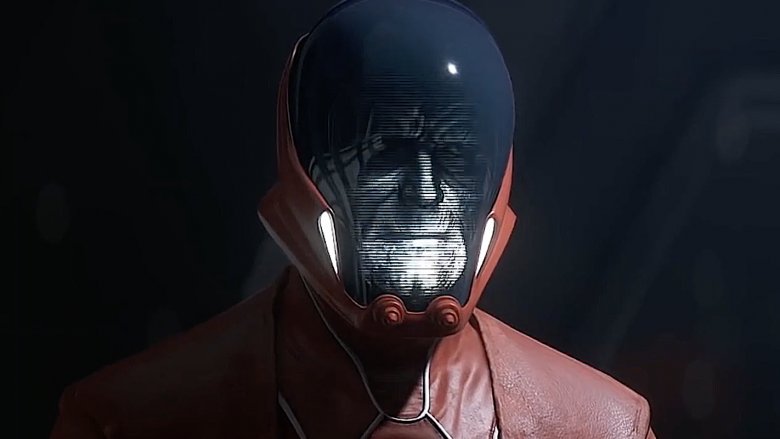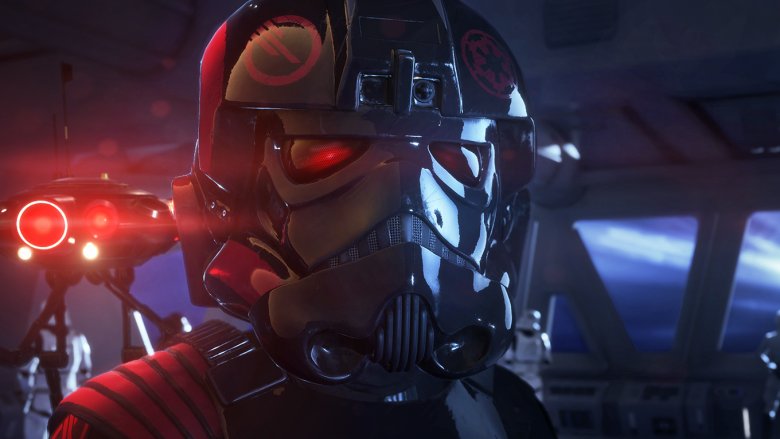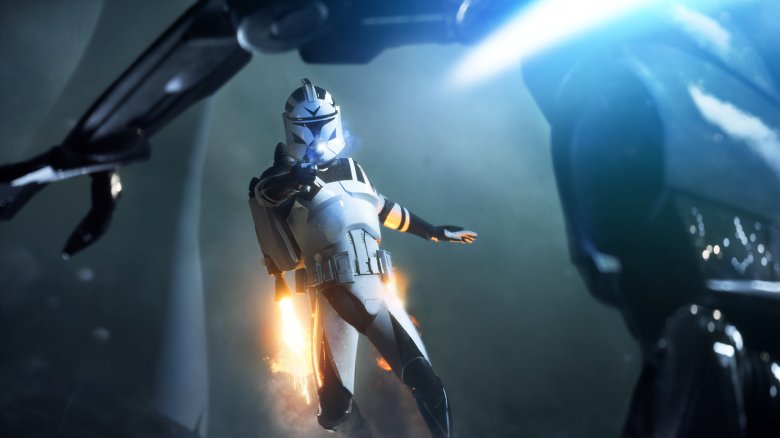What Really Went Wrong With Star Wars: Battlefront II
A long time ago in a galaxy far, far away, gamers had high hopes for the next entry in Electronic Arts' Star Wars' Battlefront series. The sequel to 2015's lukewarmly-received shooter promised more nods to the franchise's ever-expanding universe, more battle modes (including space battles), free downloadable content, and an actual single-player campaign.
On paper, those promises sounded like every Star Wars fanatic's dream come true. But when reports said game would rely heavily upon microtransactions, gamers faced a rude awakening as their collective fantasy crumbled beneath the shadow of EA's empire. Unfortunately, pay-to-win player incentives weren't the only dark forces at play in the increasingly grim months leading up to the release of the once-promising title. Let's take a look at what really went wrong with Star Wars: Battlefront II.
A complicated progression system
When 2015's Battlefront hit shelves, the exclusively multiplayer game proved to be a flawed yet engaging rumpus across the surface of intergalactic fan-favorite landscapes. But while the title's nostalgic ambiance seemed pitch perfect at first, a few rounds with your pals revealed its shortcomings in one major area: replayability.
Not only did the game launch with a mere four planets—each with its own set of smaller regions—but its progression system boiled down to this: collect experience points, level up, earn credits, and unlock more gear via "Star Cards." Many reviewers panned its simplicity, claiming that such a bare bones system would result in players getting real bored, real fast. In response, the developers switched things up in the sequel. And, in the process, they turned what could have been an accessible yet complex reimagining of Battlefront's Star Card system into a complicated mess.
Where the first entry in the series saw players upgrading their weapons, accessories, and abilities by customizing four-card hands, the secret to getting ahead in Battlefront II means juggling three different currencies—crystals, credits, and crafting parts—while simultaneously expanding your Star Card deck as you grow in both class level and player rank. But that's just the tip of the iceberg—if you really wanna get ahead, you're going to want to dish out your hard-earned dough for a couple loot crates and start raking in goodies the easy way.
While we're on the topic of spending even more money on a $60 game...
It relies too heavily on loot crates
For better or worse, trends come and go quickly in the world of gaming. And while some features prove practical, inventive, and even groundbreaking—take the autosave feature, for example—others don't. And there's no trending feature we'd rather see go straight into the sarlacc pit than the vile microtransaction. Unfortunately, Battlefront II relies heavily upon these definitely-not-kiddy-gambling-schemes to "reward' players with randomized items like Star Cards and crafting parts in exchange for real-world cash.
In other words: Star Wars: Battlefront II is now pay-to-win.
While loot crates are a relatively common feature in more games than you could possibly imagine, Battlefront II's implementation of them is extra disheartening. Its developers seemed totally adamant about keeping microtransactions out of the first game in the series when it dropped in 2015. It was even one of their talking points—a decision they appeared, at least, to take pride in.
Adding loot boxes into a game targeted toward teens and young adults has become such a controversial move that Belgium's Gaming Commission has actually launched an investigation into Battlefront II to determine whether or not the move does, in fact, constitute gambling. If so, Gamespot reports that the publishers could face a major fine, and the game may even be pulled from the country's shelves.
DICE is in damage control mode
Fans' frustration seemingly reached a boiling point after a surprisingly courteous Reddit AMA failed to convince fans that EA and the game's developer, DICE, had gamers' best interests in mind. YouTube gaming news guru YongYea even reported that the Battlefront controversy had reached the front page of CNN Tech, meaning fans' backlash was no longer reserved for niche corners of the web like gaming sites and Let's Player rants. It appeared as though DICE had no choice but to pull microtransactions from Battlefront II. And so, that's exactly what EA did—only, they've stated that this is a temporary move rather than an overhaul of their game's progression system.
Rather than outright remove loot boxes and buyable crystals, the devs simply disabled them for the time being, stating in a blog post that they would be re-integrated at a later time, but "only after we've made changes to the game." As to what those changes are, we can only speculate, though an EA representative has already confirmed that they have no intention of removing microtransactions altogether—they simply intend to "balance" them.
DICE General Manager Oskar Gabrielson has pledged to keep fans updated as they go forward with whatever tweaks they decide to bring to the troubled title.
Popular heroes and villains are locked
Hate to break it to you, but If you'd planned on hopping into your X-wing-themed gaming chair and taking everybody's favorite farmboy-turned-Jedi for a spin, you'd better get ready for a 40-hour grindfest—or enough microtransactions to have Belgium's gambling authorities fast-roping through your ceiling via helicopter. The likes of Luke Skywalker and Darth Vader, two characters synonymous with Star Wars itself, have been locked behind a paywall. They're joined by a whole slew of other heroes and villains like Emperor Palpatine, Leia, Chewie, and even the main playable character of the single-player campaign, Iden Versio.
Sure—you could spend a weekend or two duking it out in online multiplayer, unlocking a few credits here and there in your quest to amass Battlefront II's galactic pantheon of playable characters. But it's estimated that gaining access to everything that the devs have hidden away in the game would set you back approximately 4,528 hours—or, potentially, an equally unprecedented $2,100.
It was estimated that Luke Skywalker, who was originally set to cost 60,000 credits, would take 40 hours to unlock. After an outpouring of complaints from fans, EA dialed back their credit requirements for Luke, Vader, and the rest, reducing their credit requirements by 75 percent each.
However, the Sith behind the scenes also made one additional change to the game, to, you know, "level the playing field"...
The developers cut campaign reward points
Purchasing shady loot crates and grinding through multiplayer battles aren't the only way to accrue credits in Battlefront II. Gamers also have the option of taking control of one Iden Versio, Imperial Inferno Squad Commander-turned-member of the Rebellion. Completing the single-player campaign, a brand new addition to the Battlefront series, was originally set to provide players with 20,000 credits—a hefty sum for taking the time to play such a lovingly crafted homage to the Star Wars franchise.
Except that ended up not being the case at all. After EA cut their heroes' credit requirements to the point that they were almost affordable, they also reduced the amount of credits awarded to players upon their completion of the single-player campaign. Dropping the campaign's credit reward from 20,000—an amount that could unlock the newly-reduced Skywalker—to 5,000, the developers all but force players to hit up those multiplayer maps (or their checking accounts).
But who knows? Maybe players won't mind keeping their single-player and multiplayer experiences separate. Maybe Battlefront II's single-player campaign more than makes up for its credit reward reduction with a compelling narrative and fully-realized characters.
Oh, wait.
The single-player campaign is forgettable
Despite what single-player mode's developer Motive (who worked alongside DICE and Criterion Games) would have you believe, a number of reviewers all seem to agree that Battlefront's campaign is a letdown. Even positive reviews hosted criticisms ranging from claims that it felt tacked on to reports of little to no character development, too many playable character swaps, and an overreliance upon fan service in spite of the campaign's promising new character, Versio.
While not exceptionally damning, Battlefront II's single-player campaign just didn't live up to the hype. An immersive, lore-expansive adventure starring a new character ripe for development might have gone a long way in saving the controversial title from fan-outrage. The game had the potential to offset its transparently pay-to-win multiplayer mode with an expansive single-player campaign, but instead it fell short, delivering a technically impressive yet narratively forgettable five hours of fan-service punctuated with a teaser for new content once The Last Jedi rolls around come December 2017.
Oh well. Single-player gamers can always take up arms in arcade mode, which allows players to customize their gameplay style all the while utilizing heroes, Star Card hands, and all the gear they've amassed via multiplayer mode. Nothing wrong with Arcade Mode, right?
Right?
Arcade Mode credits have daily limits
If there's one thing that gamers hate, it's being told that they can't play with their new toys the way they want to. EA must have missed the memo. In addition to locking away the only characters that anybody wants to play, and just about eliminating players' rewards for trudging through the single-player campaign, EA made one last tweak to ensure consumers would have to empty their pockets to experience the full-extent of their new game: implementing a cooldown period for credit collection in arcade mode.
Sure, Arcade Mode is meant to be a chill, non-competitive space where gamers can play through a series of pre-made scenarios or personalize their own mini-adventures. It even allows for local multiplayer, meaning a whole sofa's worth of aspiring Jedi can join in on the fun. But when a game offers players credits for accomplishing feats and reaching milestones in both its single-player campaign and online multiplayer, then why not extend the same offer to those who are playing from the comfort of Arcade Mode?
It's not a measure to crack down on credit farming, as the publisher claims. It's really just another way that EA encourages its players to purchase loot boxes rather than upgrade their gameplay experience by having, you know, actual fun at their own pace.
Fans are speaking out
As you've probably gathered by now, fans are not happy with the way Battlefront II's development has been handled since its E3 2017 premiere, frequently comparing it to grind-heavy free-to-play games that don't cost $60 because... they're free to play. Angry gamers quickly took to voicing their grievances. It wasn't pretty, and when EA finally decided to step in in an attempt to quell fans' fears, Redditors watched as the Star Wars Battlefront subreddit experienced the internet equivalent of a dogpile: EA's comment defending its plans for the game received the largest number of downvotes in Reddit history. Even Wall Street is starting to sweat, as poor sales could affect EA's investors.
The rise and fall of such a promising game is a disheartening sight to behold. If had EA swapped out its sketchy pay-to-win lootboxes with microtransactional cosmetic skins—a practice long used in games like Overwatch—multiplayer battles could become eye-catching, cinematic melees as gamers showed off their swag while simultaneously blasting one another into stardust. And it's almost hard not to feel bad for co-developer DICE, who is reportedly "incredibly saddened" by the game's early negative reception.
Almost.

